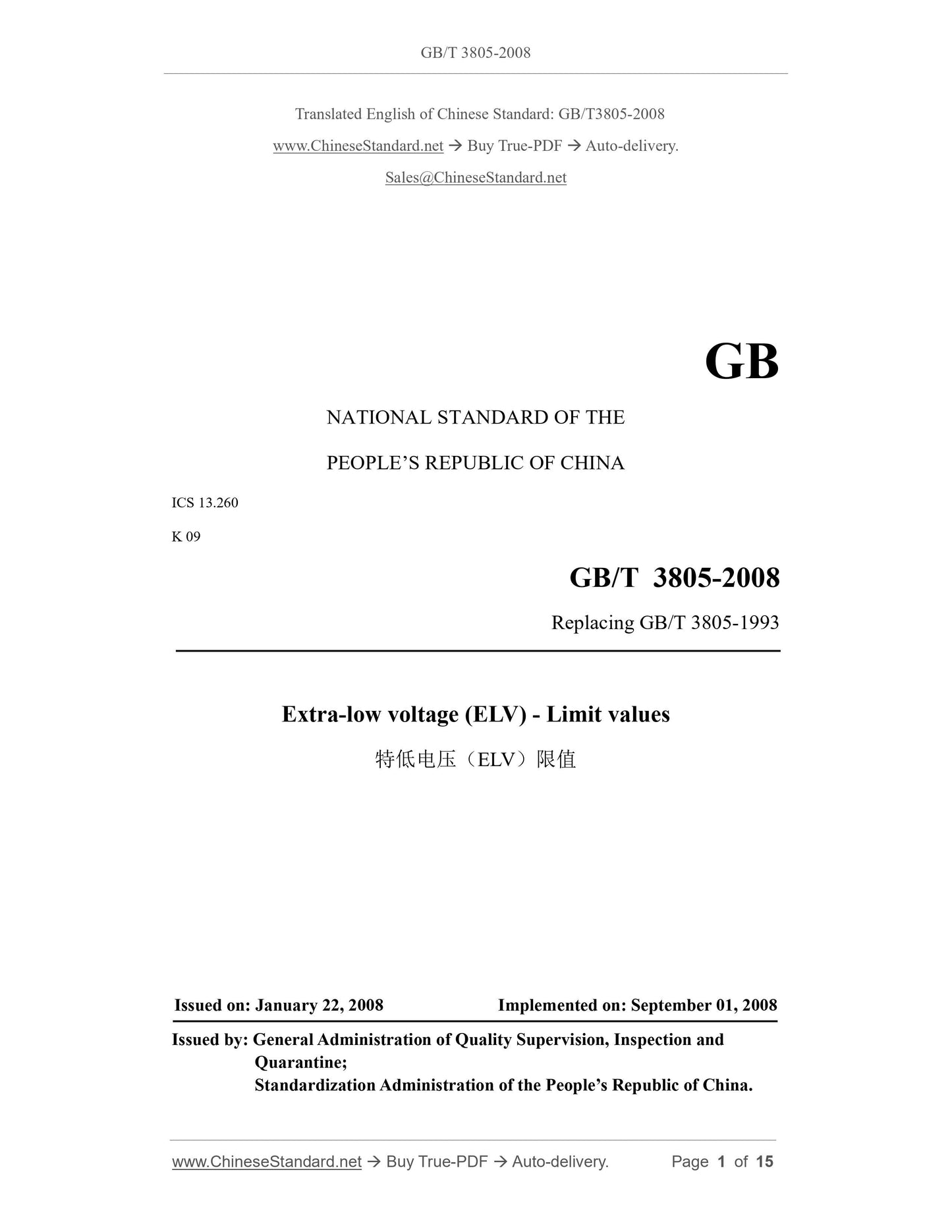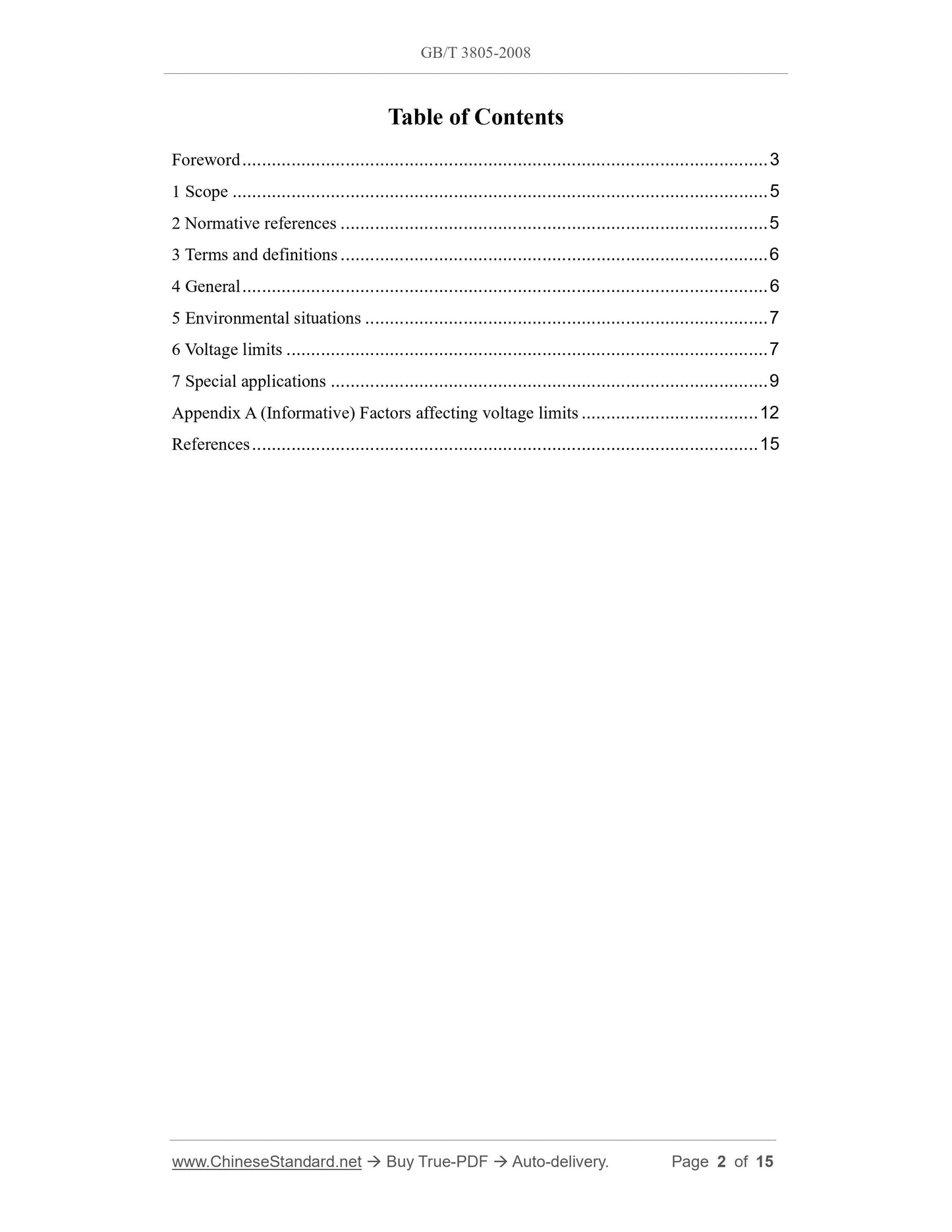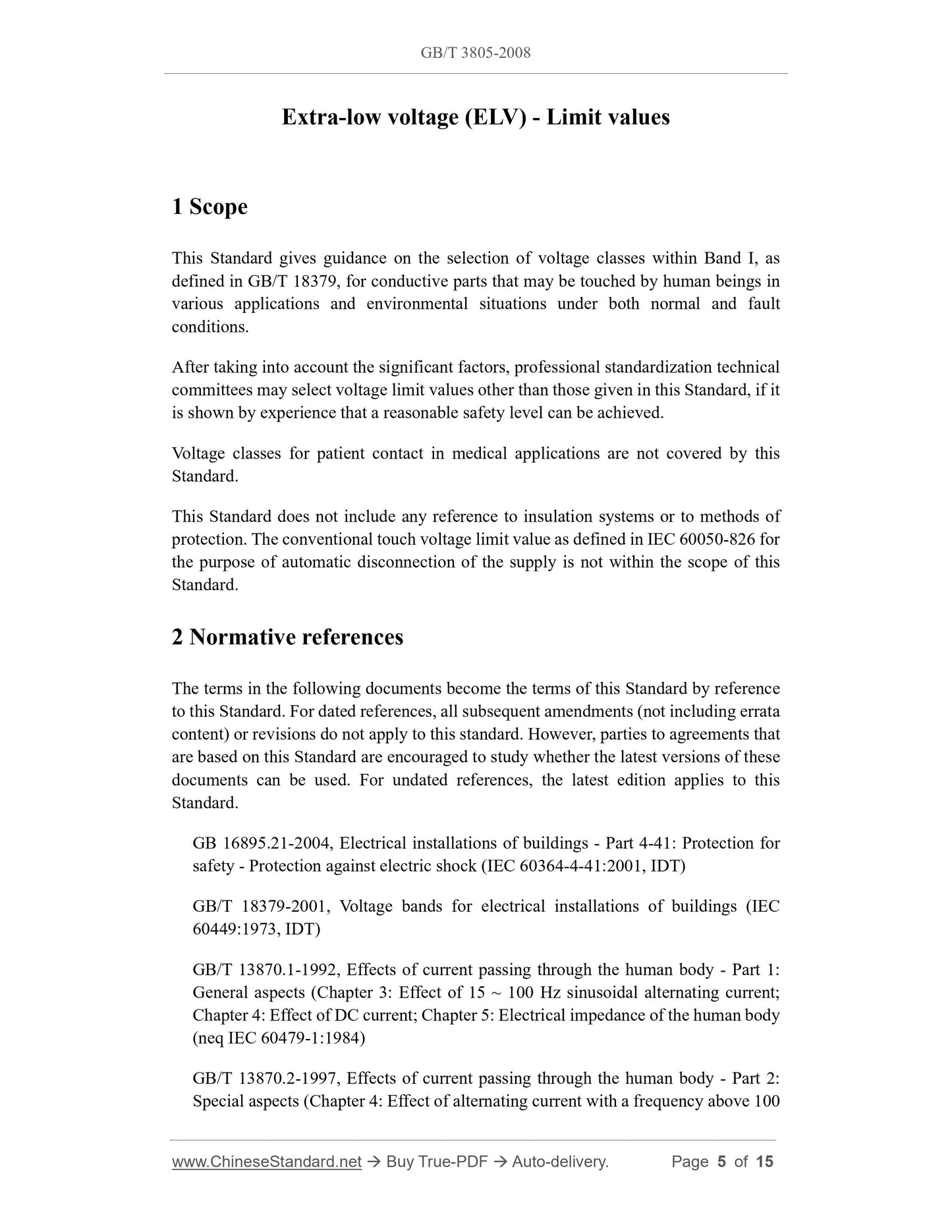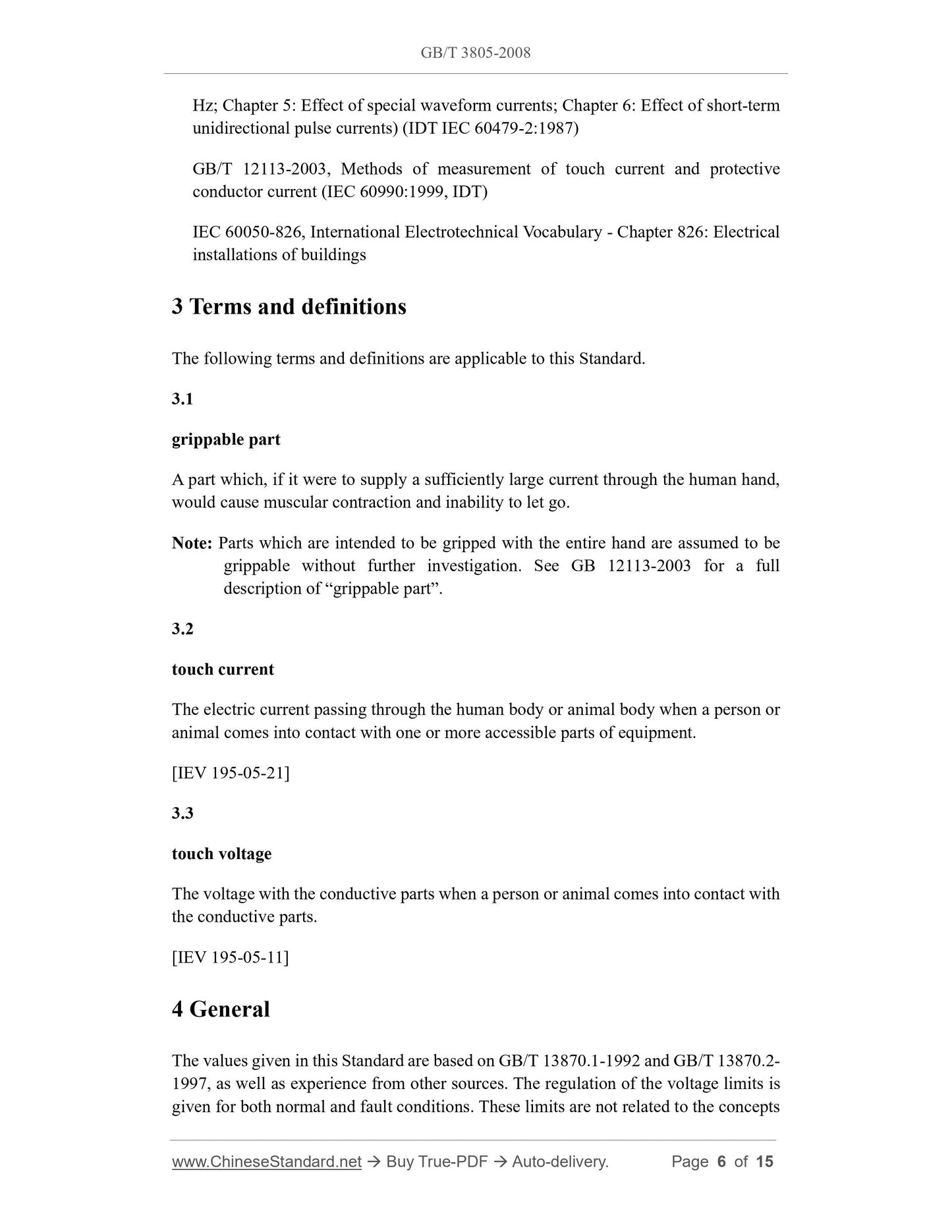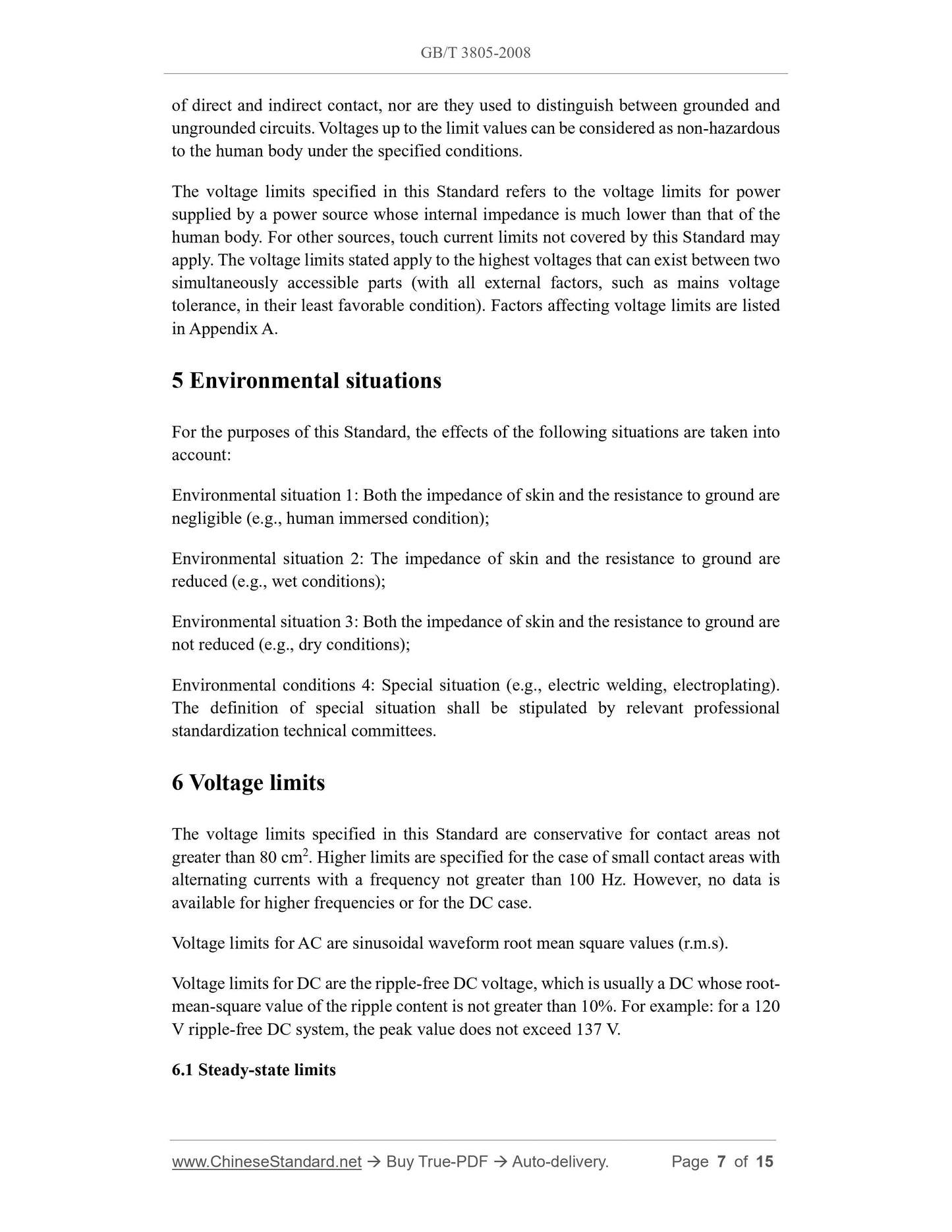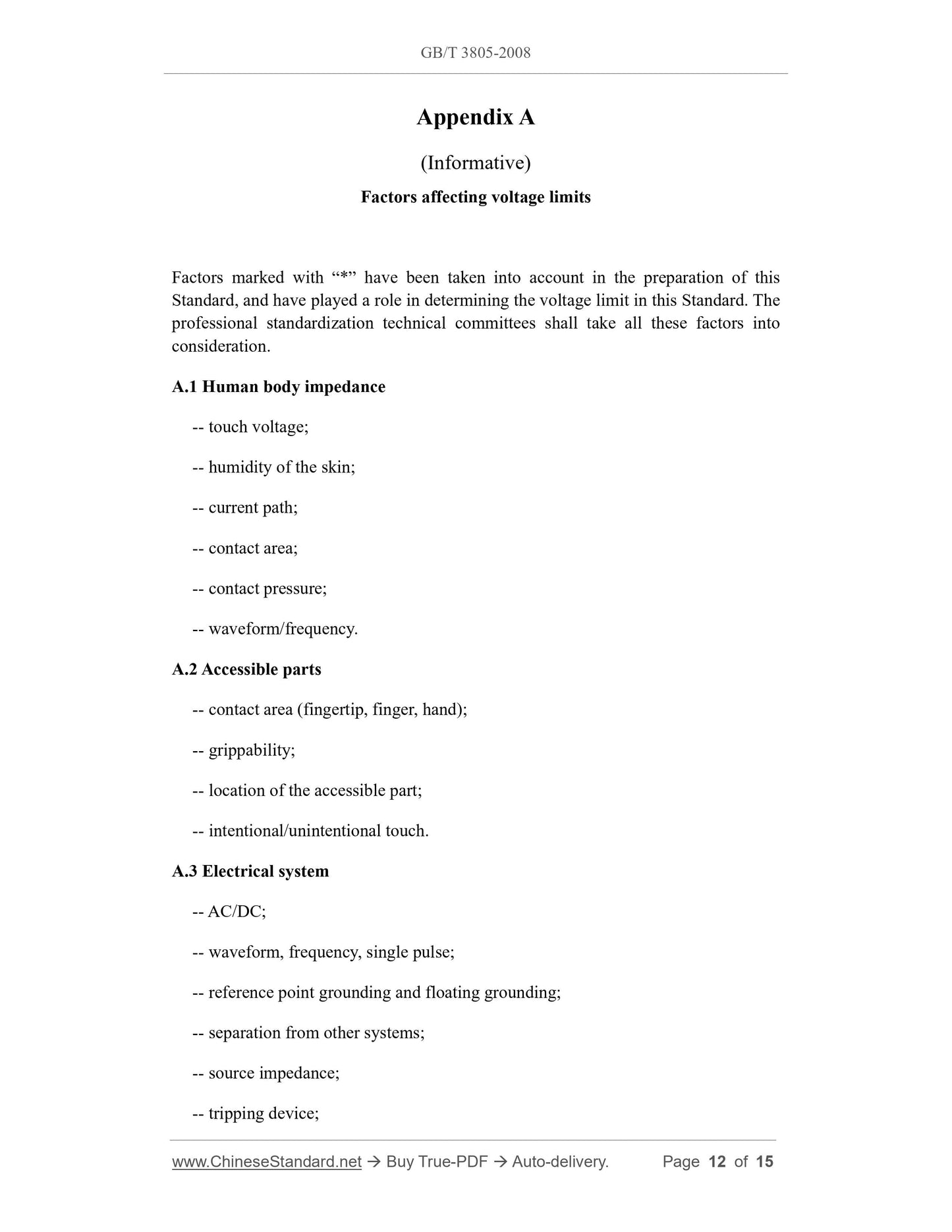1
/
of
6
PayPal, credit cards. Download editable-PDF and invoice in 1 second!
GB/T 3805-2008 English PDF (GBT3805-2008)
GB/T 3805-2008 English PDF (GBT3805-2008)
Regular price
$160.00 USD
Regular price
Sale price
$160.00 USD
Unit price
/
per
Shipping calculated at checkout.
Couldn't load pickup availability
Delivery: 3 seconds. Download true-PDF + Invoice.
Get QUOTATION in 1-minute: Click GB/T 3805-2008
Historical versions: GB/T 3805-2008
Preview True-PDF (Reload/Scroll if blank)
GB/T 3805-2008: Extra-low voltage (ELV) -- Limit values
GB/T 3805-2008
GB
NATIONAL STANDARD OF THE
PEOPLE’S REPUBLIC OF CHINA
ICS 13.260
K 09
Replacing GB/T 3805-1993
Extra-low voltage (ELV) - Limit values
ISSUED ON: JANUARY 22, 2008
IMPLEMENTED ON: SEPTEMBER 01, 2008
Issued by: General Administration of Quality Supervision, Inspection and
Quarantine;
Standardization Administration of the People’s Republic of China.
Table of Contents
Foreword ... 3
1 Scope ... 5
2 Normative references ... 5
3 Terms and definitions ... 6
4 General ... 6
5 Environmental situations ... 7
6 Voltage limits ... 7
7 Special applications ... 9
Appendix A (Informative) Factors affecting voltage limits ... 12
References ... 15
Extra-low voltage (ELV) - Limit values
1 Scope
This Standard gives guidance on the selection of voltage classes within Band I, as
defined in GB/T 18379, for conductive parts that may be touched by human beings in
various applications and environmental situations under both normal and fault
conditions.
After taking into account the significant factors, professional standardization technical
committees may select voltage limit values other than those given in this Standard, if it
is shown by experience that a reasonable safety level can be achieved.
Voltage classes for patient contact in medical applications are not covered by this
Standard.
This Standard does not include any reference to insulation systems or to methods of
protection. The conventional touch voltage limit value as defined in IEC 60050-826 for
the purpose of automatic disconnection of the supply is not within the scope of this
Standard.
2 Normative references
The terms in the following documents become the terms of this Standard by reference
to this Standard. For dated references, all subsequent amendments (not including errata
content) or revisions do not apply to this standard. However, parties to agreements that
are based on this Standard are encouraged to study whether the latest versions of these
documents can be used. For undated references, the latest edition applies to this
Standard.
GB 16895.21-2004, Electrical installations of buildings - Part 4-41: Protection for
safety - Protection against electric shock (IEC 60364-4-41:2001, IDT)
GB/T 18379-2001, Voltage bands for electrical installations of buildings (IEC
60449:1973, IDT)
GB/T 13870.1-1992, Effects of current passing through the human body - Part 1:
General aspects (Chapter 3: Effect of 15 ~ 100 Hz sinusoidal alternating current;
Chapter 4: Effect of DC current; Chapter 5: Electrical impedance of the human body
(neq IEC 60479-1:1984)
GB/T 13870.2-1997, Effects of current passing through the human body - Part 2:
Special aspects (Chapter 4: Effect of alternating current with a frequency above 100
Hz; Chapter 5: Effect of special waveform currents; Chapter 6: Effect of short-term
unidirectional pulse currents) (IDT IEC 60479-2:1987)
GB/T 12113-2003, Methods of measurement of touch current and protective
conductor current (IEC 60990:1999, IDT)
IEC 60050-826, International Electrotechnical Vocabulary - Chapter 826: Electrical
installations of buildings
3 Terms and definitions
The following terms and definitions are applicable to this Standard.
3.1
grippable part
A part which, if it were to supply a sufficiently large current through the human hand,
would cause muscular contraction and inability to let go.
Note: Parts which are intended to be gripped with the entire hand are assumed to be
grippable without further investigation. See GB 12113-2003 for a full
description of “grippable part”.
3.2
touch current
The electric current passing through the human body or animal body when a person or
animal comes into contact with one or more accessible parts of equipment.
[IEV 195-05-21]
3.3
touch voltage
The voltage with the conductive parts when a person or animal comes into contact with
the conductive parts.
[IEV 195-05-11]
4 General
The values given in this Standard are based on GB/T 13870.1-1992 and GB/T 13870.2-
1997, as well as experience from other sources. The regulation of the voltage limits is
given for both normal and fault conditions. These limits are not related to the concepts
of direct and indirect contact, nor are they used to distinguish between grounded and
ungrounded circuits. Voltages up to the limit values can be considered as non-hazardous
to the human body under the specified conditions.
The voltage limits specified in this Standard refers to the voltage limits for power
supplied by a power source whose internal impedance is much lower than that of the
human body. For other sources, touch current limits not covered by this Standard may
apply. The voltage limits stated apply to the highest voltages that can exist between two
simultaneously accessible parts (with all external factors, such as mains voltage
tolerance, in their least favorable condition). Factors affecting voltage limits are listed
in Appendix A.
5 Environmental situations
For the purposes of this Standard, the effects of the following situations are taken into
account:
Environmental situation 1: Both the impedance of skin and the resistance to ground are
negligible (e.g., human immersed condition);
Environmental situation 2: The impedance of skin and the resistance to ground are
reduced (e.g., wet conditions);
Environmental situation 3: Both the impedance of skin and the resistance to ground are
not reduced (e.g., dry conditions);
Environmental conditions 4: Special situation (e.g., electric welding, electroplating).
The definition of special situation shall be stipulated by relevant professional
standardization technical committees.
6 Voltage limits
The voltage limits specified in this Standard are conservative for contact areas not
greater than 80 cm2. Higher limits are specified for the case of small contact areas with
alternating currents with a frequency not greater than 100 Hz. However, no data is
available for higher frequencies or for the DC case.
Voltage limits for AC are sinusoidal waveform root mean square values (r.m.s).
Voltage limits for DC are the ripple-free DC voltage, which is usually a DC whose root-
mean-square value of the ripple content is not greater than 10%. For example: for a 120
V ripple-free DC system, the peak value does not exceed 137 V.
6.1 Steady-state limits
Appendix A
(Informative)
Factors affecting voltage limits
Factors marked with “*” have been taken into account in the preparation of this
Standard, and have played a role in determining the voltage limit in this Standard. The
professional standardization technical committees shall take all these factors into
consideration.
A.1 Human body impedance
-- touch voltage;
-- humidity of the skin;
-- current path;
-- contact area;
-- contact pressure;
-- waveform/frequency.
A.2 Accessible parts
-- contact area (fingertip, finger, hand);
-- grippability;
-- location of the accessible part;
-- intentional/unintentional touch.
A.3 Electrical system
-- AC/DC;
-- waveform, frequency, single pulse;
-- reference point grounding and floating grounding;
-- separation from other systems;
-- source impedance;
-- tripping device;
Get QUOTATION in 1-minute: Click GB/T 3805-2008
Historical versions: GB/T 3805-2008
Preview True-PDF (Reload/Scroll if blank)
GB/T 3805-2008: Extra-low voltage (ELV) -- Limit values
GB/T 3805-2008
GB
NATIONAL STANDARD OF THE
PEOPLE’S REPUBLIC OF CHINA
ICS 13.260
K 09
Replacing GB/T 3805-1993
Extra-low voltage (ELV) - Limit values
ISSUED ON: JANUARY 22, 2008
IMPLEMENTED ON: SEPTEMBER 01, 2008
Issued by: General Administration of Quality Supervision, Inspection and
Quarantine;
Standardization Administration of the People’s Republic of China.
Table of Contents
Foreword ... 3
1 Scope ... 5
2 Normative references ... 5
3 Terms and definitions ... 6
4 General ... 6
5 Environmental situations ... 7
6 Voltage limits ... 7
7 Special applications ... 9
Appendix A (Informative) Factors affecting voltage limits ... 12
References ... 15
Extra-low voltage (ELV) - Limit values
1 Scope
This Standard gives guidance on the selection of voltage classes within Band I, as
defined in GB/T 18379, for conductive parts that may be touched by human beings in
various applications and environmental situations under both normal and fault
conditions.
After taking into account the significant factors, professional standardization technical
committees may select voltage limit values other than those given in this Standard, if it
is shown by experience that a reasonable safety level can be achieved.
Voltage classes for patient contact in medical applications are not covered by this
Standard.
This Standard does not include any reference to insulation systems or to methods of
protection. The conventional touch voltage limit value as defined in IEC 60050-826 for
the purpose of automatic disconnection of the supply is not within the scope of this
Standard.
2 Normative references
The terms in the following documents become the terms of this Standard by reference
to this Standard. For dated references, all subsequent amendments (not including errata
content) or revisions do not apply to this standard. However, parties to agreements that
are based on this Standard are encouraged to study whether the latest versions of these
documents can be used. For undated references, the latest edition applies to this
Standard.
GB 16895.21-2004, Electrical installations of buildings - Part 4-41: Protection for
safety - Protection against electric shock (IEC 60364-4-41:2001, IDT)
GB/T 18379-2001, Voltage bands for electrical installations of buildings (IEC
60449:1973, IDT)
GB/T 13870.1-1992, Effects of current passing through the human body - Part 1:
General aspects (Chapter 3: Effect of 15 ~ 100 Hz sinusoidal alternating current;
Chapter 4: Effect of DC current; Chapter 5: Electrical impedance of the human body
(neq IEC 60479-1:1984)
GB/T 13870.2-1997, Effects of current passing through the human body - Part 2:
Special aspects (Chapter 4: Effect of alternating current with a frequency above 100
Hz; Chapter 5: Effect of special waveform currents; Chapter 6: Effect of short-term
unidirectional pulse currents) (IDT IEC 60479-2:1987)
GB/T 12113-2003, Methods of measurement of touch current and protective
conductor current (IEC 60990:1999, IDT)
IEC 60050-826, International Electrotechnical Vocabulary - Chapter 826: Electrical
installations of buildings
3 Terms and definitions
The following terms and definitions are applicable to this Standard.
3.1
grippable part
A part which, if it were to supply a sufficiently large current through the human hand,
would cause muscular contraction and inability to let go.
Note: Parts which are intended to be gripped with the entire hand are assumed to be
grippable without further investigation. See GB 12113-2003 for a full
description of “grippable part”.
3.2
touch current
The electric current passing through the human body or animal body when a person or
animal comes into contact with one or more accessible parts of equipment.
[IEV 195-05-21]
3.3
touch voltage
The voltage with the conductive parts when a person or animal comes into contact with
the conductive parts.
[IEV 195-05-11]
4 General
The values given in this Standard are based on GB/T 13870.1-1992 and GB/T 13870.2-
1997, as well as experience from other sources. The regulation of the voltage limits is
given for both normal and fault conditions. These limits are not related to the concepts
of direct and indirect contact, nor are they used to distinguish between grounded and
ungrounded circuits. Voltages up to the limit values can be considered as non-hazardous
to the human body under the specified conditions.
The voltage limits specified in this Standard refers to the voltage limits for power
supplied by a power source whose internal impedance is much lower than that of the
human body. For other sources, touch current limits not covered by this Standard may
apply. The voltage limits stated apply to the highest voltages that can exist between two
simultaneously accessible parts (with all external factors, such as mains voltage
tolerance, in their least favorable condition). Factors affecting voltage limits are listed
in Appendix A.
5 Environmental situations
For the purposes of this Standard, the effects of the following situations are taken into
account:
Environmental situation 1: Both the impedance of skin and the resistance to ground are
negligible (e.g., human immersed condition);
Environmental situation 2: The impedance of skin and the resistance to ground are
reduced (e.g., wet conditions);
Environmental situation 3: Both the impedance of skin and the resistance to ground are
not reduced (e.g., dry conditions);
Environmental conditions 4: Special situation (e.g., electric welding, electroplating).
The definition of special situation shall be stipulated by relevant professional
standardization technical committees.
6 Voltage limits
The voltage limits specified in this Standard are conservative for contact areas not
greater than 80 cm2. Higher limits are specified for the case of small contact areas with
alternating currents with a frequency not greater than 100 Hz. However, no data is
available for higher frequencies or for the DC case.
Voltage limits for AC are sinusoidal waveform root mean square values (r.m.s).
Voltage limits for DC are the ripple-free DC voltage, which is usually a DC whose root-
mean-square value of the ripple content is not greater than 10%. For example: for a 120
V ripple-free DC system, the peak value does not exceed 137 V.
6.1 Steady-state limits
Appendix A
(Informative)
Factors affecting voltage limits
Factors marked with “*” have been taken into account in the preparation of this
Standard, and have played a role in determining the voltage limit in this Standard. The
professional standardization technical committees shall take all these factors into
consideration.
A.1 Human body impedance
-- touch voltage;
-- humidity of the skin;
-- current path;
-- contact area;
-- contact pressure;
-- waveform/frequency.
A.2 Accessible parts
-- contact area (fingertip, finger, hand);
-- grippability;
-- location of the accessible part;
-- intentional/unintentional touch.
A.3 Electrical system
-- AC/DC;
-- waveform, frequency, single pulse;
-- reference point grounding and floating grounding;
-- separation from other systems;
-- source impedance;
-- tripping device;
Share
